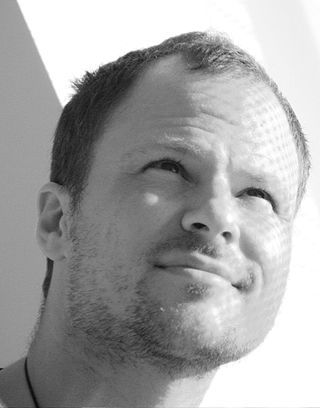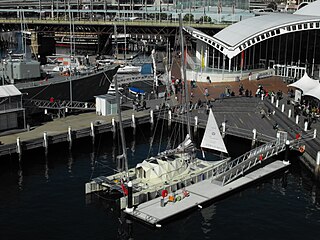
Biomimetics or biomimicry is the emulation of the models, systems, and elements of nature for the purpose of solving complex human problems. The terms "biomimetics" and "biomimicry" are derived from Ancient Greek: βίος (bios), life, and μίμησις (mīmēsis), imitation, from μιμεῖσθαι (mīmeisthai), to imitate, from μῖμος (mimos), actor. A closely related field is bionics.
Sir Michael John Hopkins was an English architect.

The Royal Institute of British Architects (RIBA) is a professional body for architects primarily in the United Kingdom, but also internationally, founded for the advancement of architecture under its royal charter granted in 1837, three supplemental charters and a new charter granted in 1971.
Janine M. Benyus is an American natural sciences writer, innovation consultant, and author. After writing books on wildlife and animal behavior, she coined the term Biomimicry to describe intentional problem-solving design inspired by nature. Her book Biomimicry (1997) attracted widespread attention from businesspeople in design, architecture, and engineering as well as from scientists. Benyus argues that by following biomimetic approaches, designers can develop products that will perform better, be less expansive, use less energy, and leave companies less open to legal risk.

Bionics or biologically inspired engineering is the application of biological methods and systems found in nature to the study and design engineering systems and modern technology.

Maggie's centres are a network of drop-in centres across the United Kingdom and Hong Kong, which aim to help anyone who has been affected by cancer. They are not intended as a replacement for conventional cancer therapy, but as a caring environment that can provide support, information and practical advice. They are located near, but are detached from, existing NHS hospitals.

Chris Bosse is a German-born architect. He was a designer of the Beijing National Aquatics Centre, which was built for the 2008 Summer Olympics.

The Plastiki is a 60-foot (18 m) catamaran made out of 12,500 reclaimed plastic bottles and other recycled PET plastic and waste products. Michael Pawlyn of Exploration Architecture worked on the concept design with David de Rothschild and helped to shape some of the key ideas. The craft was built using cradle to cradle design philosophies and features many renewable energy systems, including solar panels, wind and trailing propeller turbines, and bicycle generators. The frame was designed by Australian naval architect Andrew Dovell. The boat's name is a play on the 1947 Kon-Tiki raft used to sail across the Pacific by Norwegian explorer Thor Heyerdahl, and its voyage roughly followed the same route.
Grimshaw Architects is an architectural firm based in London. Founded in 1980 by Nicholas Grimshaw, the firm was one of the pioneers of high-tech architecture. In particular, they are known for their design of transport projects including Amsterdam Bijlmer ArenA railway station, Waterloo International railway station and the award-winning Southern Cross railway station which was the recipient of the Royal Institute of British Architects Lubetkin Prize. Grimshaw is behind the design of the Sustainability Pavilion, an innovative net-zero building, for Expo 2020. The firm currently has offices in Los Angeles, New York, London, Paris, Dubai, Melbourne and Sydney, employing over 600 staff.

Feilden Clegg Bradley Studios is a British architectural design firm, established in 1978, with offices in Bath, London, Manchester and Belfast. The firm is known for its pioneering work in sustainable design and social design agenda.
The Biomimicry Institute is a 501(c)(3) not-for-profit organization founded in 2006 and based in Missoula, Montana in the United States. Its goal is to help innovators learn from nature in order to design sustainable products, processes, and policies in response to real-world problems. The Biomimicry Institute has become a key communicator in the field of biomimetics, connecting thousands of practitioners and organizations across the world. Its Global Network currently supports 38 regional networks across 26 countries as of 2022. The Biomimicry Institute was founded by Bryony Schwan, Dayna Baumeister and Janine Benyus and originated following the publishing of Biomimicry: Innovation Inspired by Nature by Janine Benyus; a natural sciences writer, innovation consultant and author.
RIBA Competitions is the Royal Institute of British Architects' unit dedicated to organising architectural and other design-related competitions.

The RIBA President's Medals are international awards presented annually by the Royal Institute of British Architects (RIBA) to architecture students or recent graduates. Participation is by direct invitation only to over 500 schools of architecture located in 100 countries. Schools are invited to nominate up to 2 entries for the Bronze Medal, up to 2 entries for the Silver Medal, and 1 entry for the Dissertation Medal. In 2023, a record 238 entries were received from 103 schools located in 35 countries.
John Robertson Architects (JRA) is an architectural practice based in Bankside, London, which was founded by its Director John Robertson in 1993. The practice concentrates on the design and implementation of new build, retrofit, historic refurbishment and restoration projects in Central London. It is a member of the AJ100, consisting of the 100 largest architecture practices in the UK. JRA is a foundation member of the Landaid Appeal.
The Department of Architecture is part of the Faculty of Architecture and History of Art in the University of Cambridge. Both Departments are housed in Scroope Terrace on Trumpington Street, Cambridge.

Moti Bodek is an Israeli architect. He is the CEO of Bodek Architects based in Tel Aviv and a Professor of Architecture at Bezalel Academy of Art and Design, Jerusalem & at Tel Aviv University.
Biomimetic architecture is a branch of the new science of biomimicry defined and popularized by Janine Benyus in her 1997 book. Biomimicry refers to innovations inspired by nature as one which studies nature and then imitates or takes inspiration from its designs and processes to solve human problems. The book suggests looking at nature as a Model, Measure, and Mentor", suggesting that the main aim of biomimicry is sustainability.

Exploration Architecture was established in 2007 by architect Michael Pawlyn.
Feilden Fowles is an architectural firm based in London. It was formed in 2009 by Fergus Feilden and Edmund Fowles, who first collaborated while studying at the University of Cambridge. The practice has been recipient of several awards including Young Architect of the Year 2016. Alongside practice, Feilden Fowles has taught a studio unit at Sir John Cass School of Art, Architecture and Design, London Metropolitan University since 2015.

The year 2023 in architecture involved some significant architectural events and new buildings.












